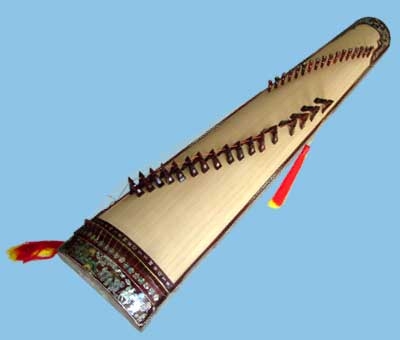When played, the instrument is placed in front of the musician, who uses her right hand to regulate the pitch and vibrate, while plucking the strings with her left hand.
The 16-string zither has a rectangular sounding box, about 110 centimeters long that tapers about 13 cm toward an end, with a warped sound board made of unvarnished light wood. The sides are made of hard wood decorated with various designs, either lacquered or inlaid with mother-of-pearl. The bottom is made of light wood with sound holes. The broader end of the sound box is pierced with 16 holes and reinforced with a metal band.
Toward the middle of the sound board there are 16 bridges made of wood or bone tipped with copper that can be moved to vary the tension of the strings, thus creating various notes. At the narrower end of the box are sixteen pegs for tuning. The strings are metal and tuned to the pentatonic scale.
 The Dan Tranh sits flat like an autoharp and is plucked using all fingers. Players will usually wear picks made of plastic or tortoise shell on their fingers to facilitate plucking. The sound reverberates through the hollow wooden box below the strings. Sounds can be altered through cupping, pressing or stroking the strings instead of simply plucking.
The Dan Tranh sits flat like an autoharp and is plucked using all fingers. Players will usually wear picks made of plastic or tortoise shell on their fingers to facilitate plucking. The sound reverberates through the hollow wooden box below the strings. Sounds can be altered through cupping, pressing or stroking the strings instead of simply plucking.
The Dan Tranh originates from the ancient capital city of Hue, where women once played it for royalty, and the instrument is still considered a symbol of the city. The Dan tranh is normally played unaccompanied, but it can also be used to accompany a singer or as part of an orchestra.
